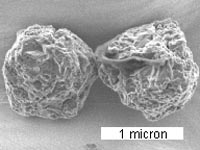默奇森陨石
| 默奇森陨石 | |
|---|---|

| |
| 华盛顿特区国家自然历史博物馆的默奇森陨石标本。 | |
| 类型 | 球粒陨石 |
| 分类 | 碳质球粒陨石 |
| 群 | CM2 |
| 组成 | 铁:22.13%,星体水:12% |
| 冲击程度 | S1–2 |
| 国家 | |
| 地区 | 维多利亚省 |
| 坐标 | 36°37′S 145°12′E / 36.617°S 145.200°E[1] |
| 坠落陨石 | Yes |
| 坠落日期 | 1969年9月28日 |
| 总已知重量 (TKW) | 100千克(220磅) |
| 一对来自默奇森陨石的颗粒 | |

| |
默奇森陨石是被研究得最多的陨石之一,不只是因为它的总质量(超过100千克或220磅),更主要因为它是一颗坠落陨石。这颗陨石于1969年坠落在澳大利亚维多利亚的默奇森附近,是一组富含有机化合物的陨石。
在2020年1月,天文学家报告说,在其中发现的碳化硅颗粒是迄今在地球上发现最古老的岩石。这些粒子的年龄经测定高达70亿年,比太阳系和地球的45亿年还要古老25亿年。 [a]发表的研究指出“尘埃颗粒的寿命估计主要依靠复杂的理论模型。然而,这些模型偏重于更常见的小尘埃颗粒,并且基于具有巨不大确定性的假设。[2]”
历史
[编辑]1969年9月28日上午10:58左右,在澳大利亚维多利亚省默奇森附近,观察到一颗明亮的火球,在消失前分裂成三块[1],并留下一团烟雾;大约30秒后,听到震摄的声音。随后在13平方千米(5.0平方英里)的区域发现许多碎片,其中有颗质量高达7千克(15英磅),还有一颗680克(1.5英磅)重的击穿屋顶后落在干草堆上[1]。搜集到的陨石总质量超过100千克(220英磅)[3]。
分类和成分
[编辑]默奇森陨石在分上属于球粒陨石的碳质球粒陨石。与大多数球粒陨石一样,默奇森陨石是第二型,这意味着它在坠落到地球之前,已经在其母体上经历了富水流体的广泛改变[4]。球粒陨石CM群与碳质球粒陨石CI群都富含碳,是化学上最原始的陨石之一[5]。像其它球粒陨石CM群一样,默奇森陨石含有丰富的钙-铝封包。对这颗陨石多次的研究,已经发现超过15种生命基本成分的氨基酸 [6]。
在2020年1月,天文学家报告说默奇森陨石中的碳化硅粒子的寿命高达70亿年,比45.4亿年的地球和太阳系大25亿年,是迄今在地球上发现的最古老的岩石[2][7]。
有机化合物
[编辑]
默奇森陨石中有常见的氨基酸,如甘氨酸、丙氨酸和谷氨酸,也有不寻常的氨基酸,如异缬氨酸和亮氨酸[8]。米勒-尤里实验中发现的混合物,像是复杂的烷烃混合物也被分离出来。通常被认为是地球污染的丝氨酸和苏氨酸,明确的不存在于样品中。在默奇森陨石中也发现特定氨基酸家族中的二氨基酸[9]。
初期的报告指出,氨基酸是外消旋混合物,而地球上蛋白质的氨基酸都是左旋性,因此是以非生物的方式形成的。后来,也是一种蛋白质氨基酸的丙氨酸被发现有多过右璇的左旋配置[10],这导致有些科学家怀疑是受到地面的污染,理由是非生物的立体选择性会分解或合成蛋白质氨基酸,而不是非蛋白质氨基酸[11]。在1997年,在非蛋白质氨基酸异缬氨酸中也发现了左旋过量[12],为太阳系中的分子不对称性提供了一个外星源。同一时间,在默奇森陨石也发现丙氨酸的左旋超量,但是富集在氮15的同位素[13];然而,同位素配对后来因为分析的基础而受到质疑[14]。到2001年,陨石中确定的有机物清单扩大到多元醇[15]。
| 复合类[16] | 浓度(ppm) |
|---|---|
| 氨基酸 | 17–60 |
| 脂肪烃 | >35 |
| 芳烃 | 3319 |
| 富勒烯 | >100 |
| 羧酸 | >300 |
| 氢碳水化合物酸 | 15 |
| 嘌呤和嘧啶 | 1.3 |
| 醇 | 11 |
| 磺氨酸 | 68 |
| 磷酸 | 2 |
| 总计 | >3911.3 |
陨石和有左旋和右旋氨基酸的混合物,在生物体使用的氨基酸,其手性大多数都是左旋,而大多数糖类都是右旋。瑞典的一个化学家团队,在2005年证明这种同手性可能是被左旋氨基酸(例如脯氨酸)触发或催化[17]。
有多方面的证据显示保存良好的默奇森陨石碎片的内部是原始的。在2010年使用高解析工具(包括光谱)的研究,在远时样本中确定14,000种分子化合物,其中包括70种氨基酸[18][19]。分析范围有限的质谱仪,提供了50,000种更多独特的分子组合物,研究小组估计陨石中可能存在数百万种不同的有机化合物 [20]。
核硷基
[编辑]使用同位素质谱仪测量在默奇森陨石中发现的嘌呤和嘧啶的碳同位素比,脲嘧啶和黄嘌呤的δ13C分别是+44.5‰ and +37.7‰,显示这些化合物并非源自地球。这个样本显示许多有机化合物可能由早期太阳系天体提供,并可能在生物发生的生命起源中发挥关键作用[21]。
相关条目
[编辑]注释
[编辑]- ^ That makes the stardust grains in the Murchison meteorite presolar grains, since they originated at a time before the Sun was formed.
参考文献
[编辑]- ^ 1.0 1.1 1.2 Meteoritical Bulletin Database: Murchison
- ^ 2.0 2.1 Heck, Philipp R.; Greer, Jennika; Kööp, Levke; Trappitsch, Reto; Gyngard, Frank; Busemann, Henner; Maden, Colin; Ávila, Janaína N.; Davis, Andrew M.; Wieler, Rainer. Lifetimes of interstellar dust from cosmic ray exposure ages of presolar silicon carbide. Proceedings of the National Academy of Sciences. 2020-01-13, 117 (4): 1884–1889. Bibcode:2020PNAS..117.1884H. PMC 6995017
 . PMID 31932423. doi:10.1073/pnas.1904573117
. PMID 31932423. doi:10.1073/pnas.1904573117  .
.
- ^ Pepper, F. When a space visitor came to country Victoria (页面存档备份,存于互联网档案馆) ABC News, 2 October 2019. Retrieved 2 October 2019.
- ^ Airieau, S. A.; Farquhar, J.; Thiemens, M. H.; Leshin, L. A.; Bao, H.; Young, E. Planetesimal sulfate and aqueous alteration in CM and CI carbonaceous chondrites. Geochimica et Cosmochimica Acta. 2005, 69 (16): 4167–4172. Bibcode:2005GeCoA..69.4167A. CiteSeerX 10.1.1.424.6561
 . doi:10.1016/j.gca.2005.01.029.
. doi:10.1016/j.gca.2005.01.029.
- ^ Planetary Science Research Discoveries: Glossary. [2012-01-24]. (原始内容存档于2012-01-24).
- ^ Wolman, Yecheskel; Haverland, William J.; Miller, Stanley L. Nonprotein Amino Acids from Spark Discharges and Their Comparison with the Murchison Meteorite Amino Acids. Proceedings of the National Academy of Sciences. April 1972, 69 (4): 809–811. Bibcode:1972PNAS...69..809W. PMC 426569
 . PMID 16591973. doi:10.1073/pnas.69.4.809.
. PMID 16591973. doi:10.1073/pnas.69.4.809.
- ^ Weisberger, Mindy. 7 Billion-Year-Old Stardust Is Oldest Material Found on Earth - Some of these ancient grains are billions of years older than our sun.. Live Science. 2020-01-13 [2020-01-13]. (原始内容存档于2020-01-14).
- ^ Kvenvolden, Keith A.; Lawless, James; Pering, Katherine; Peterson, Etta; Flores, Jose; Ponnamperuma, Cyril; Kaplan, Isaac R.; Moore, Carleton. Evidence for extraterrestrial amino-acids and hydrocarbons in the Murchison meteorite. Nature. 1970, 228 (5275): 923–926 [2009-09-09]. Bibcode:1970Natur.228..923K. PMID 5482102. doi:10.1038/228923a0. (原始内容存档于2021-11-12).
- ^ Meierhenrich, Uwe J.; Bredehöft, Jan Hendrik; Jessberger, Elmar K.; Thiemann, Wolfram H.-P. Identification of diamino acids in the Murchison meteorite. PNAS. 2004, 101 (25): 9182–9186. Bibcode:2004PNAS..101.9182M. PMC 438950
 . PMID 15194825. doi:10.1073/pnas.0403043101.
. PMID 15194825. doi:10.1073/pnas.0403043101.
- ^ Engel, Michael H.; Nagy, Bartholomew. Distribution and enantiomeric composition of amino acids in the Murchison meteorite. Nature. 1982-04-29, 296 (5860): 837–840. Bibcode:1982Natur.296..837E. doi:10.1038/296837a0.
- ^ Bada, Jeffrey L.; Cronin, John R.; Ho, Ming-Shan; Kvenvolden, Keith A.; Lawless, James G.; Miller, Stanley L.; Oro, J.; Steinberg, Spencer. On the reported optical activity of amino acids in the Murchison meteorite. Nature. 1983-02-10, 301 (5900): 494–496. Bibcode:1983Natur.301..494B. doi:10.1038/301494a0.
- ^ Cronin, John R.; Pizzarello, S. Enantiomeric excesses in meteoritic amino acids. Science. 1997, 275 (5302): 951–955. Bibcode:1997Sci...275..951C. PMID 9020072. doi:10.1126/science.275.5302.951.
- ^ Engel, Michael H.; Macko, S. A. Isotopic evidence for extraterrestrial non-racemic amino acids in the Murchison meteorite. Nature. 1997-09-01, 389 (6648): 265–268. Bibcode:1997Natur.389..265E. PMID 9305838. doi:10.1038/38460.
- ^ Pizzarello, Sandra; Cronin, JR. Alanine enantiomers in the Murchison meteorite. Nature. 1998, 394 (6690): 236. Bibcode:1998Natur.394..236P. PMID 9685155. doi:10.1038/28306.
- ^ Cooper, George; Kimmich, Novelle; Belisle, Warren; Sarinana, Josh; Brabham, Katrina; Garrel, Laurence. Carbonaceous meteorites as a source of sugar-related organic compounds for the early Earth. Nature. 2001-12-20, 414 (6866): 879–883 [2019-07-02]. Bibcode:2001Natur.414..879C. PMID 11780054. doi:10.1038/414879a. (原始内容存档于2020-01-16).
- ^ Machalek, Pavel. Organic Molecules in Comets and Meteorites and Life on Earth (PDF). Department of Physics and Astronomy (Johns Hopkins University). 2007-02-17 [2008-10-07]. (原始内容 (PDF)存档于2008-12-17).
- ^ Córdova, Armando; Engqvist, Magnus; Ibrahem, Ismail; Casas, Jesús; Sundén, Henrik. Plausible origins of homochirality in the amino acid catalyzed neogenesis of carbohydrates. Chem. Commun. 2005, (15): 2047–2049. PMID 15834501. doi:10.1039/b500589b.
- ^ Walton, Doreen. Space rock contains organic molecular feast. BBC News. 2010-02-15 [2010-02-15]. (原始内容存档于2010-02-16).
- ^ Schmitt-Kopplin, Philippe; Gabelica, Zelimir; Gougeon, Régis D.; Fekete, Agnes; Kanawati, Basem; Harir, Mourad; Gebefuegi, Istvan; Eckel, Gerhard; Hertkorn, Norbert. High molecular diversity of extraterrestrial organic matter in Murchison meteorite revealed 40 years after its fall (PDF). PNAS. 2010-02-16, 107 (7): 2763–2768 [2010-02-16]. Bibcode:2010PNAS..107.2763S. PMC 2840304
 . PMID 20160129. doi:10.1073/pnas.0912157107. (原始内容存档 (PDF)于2012-12-02).
. PMID 20160129. doi:10.1073/pnas.0912157107. (原始内容存档 (PDF)于2012-12-02).
- ^ Matson, John. Meteorite That Fell in 1969 Still Revealing Secrets of the Early Solar System. Scientific American. 2010-02-15 [2010-02-15]. (原始内容存档于2011-03-19).
- ^ Martins, Zita; Botta, Oliver; Fogel, Marilyn L.; Sephton, Mark A.; Glavin, Daniel P.; Watson, Jonathan S.; Dworkin, Jason P.; Schwartz, Alan W.; Ehrenfreund, Pascale. Extraterrestrial nucleobases in the Murchison meteorite (PDF). Earth and Planetary Science Letters. 2008-03-20, 270 (1–2): 130–136 [2008-10-07]. Bibcode:2008E&PSL.270..130M. arXiv:0806.2286
 . doi:10.1016/j.epsl.2008.03.026. (原始内容 (PDF)存档于2011-08-10).
. doi:10.1016/j.epsl.2008.03.026. (原始内容 (PDF)存档于2011-08-10).

